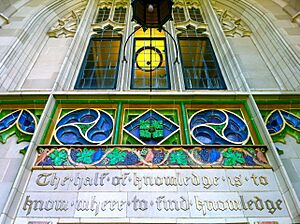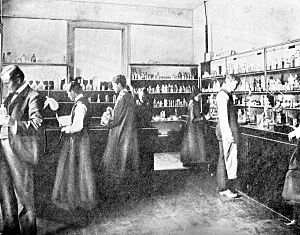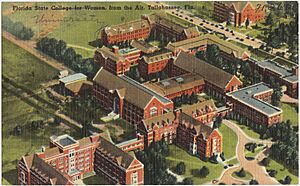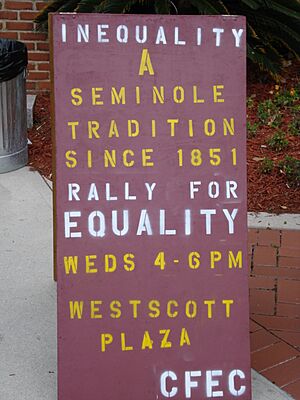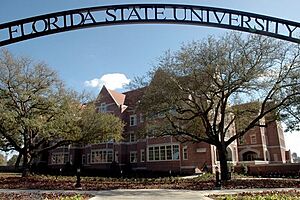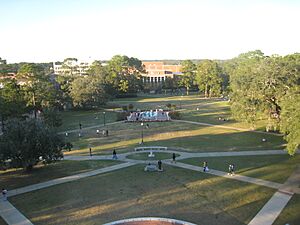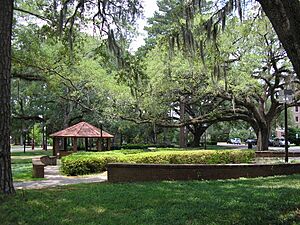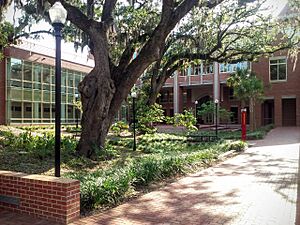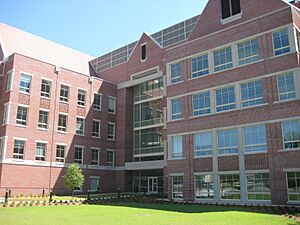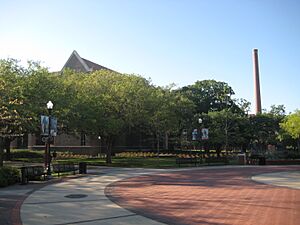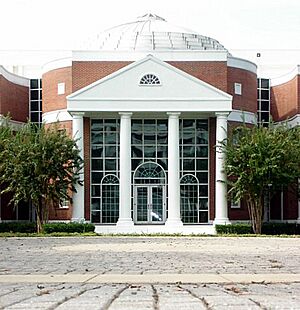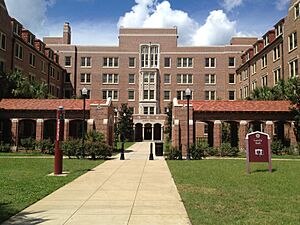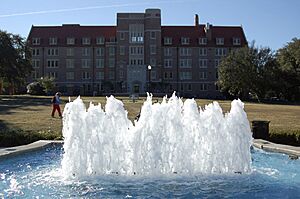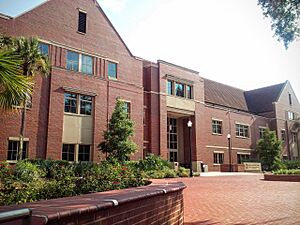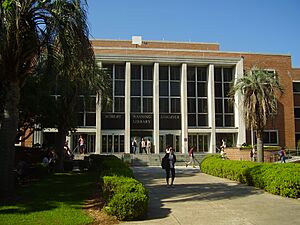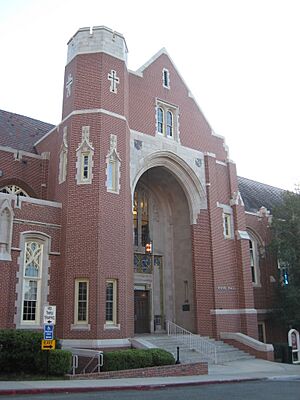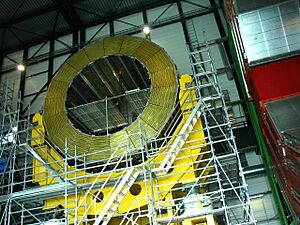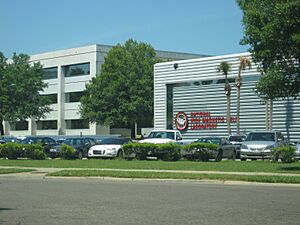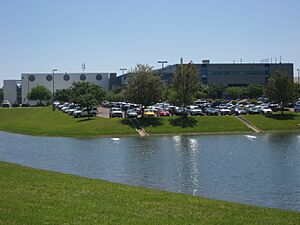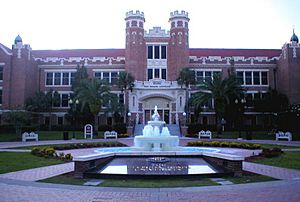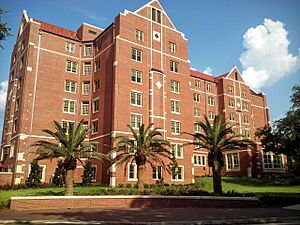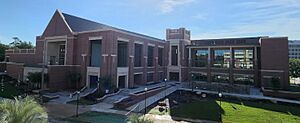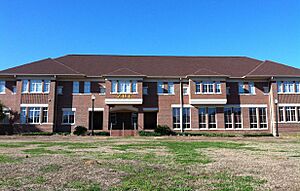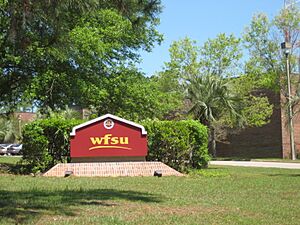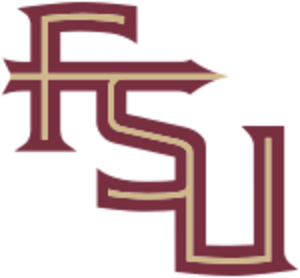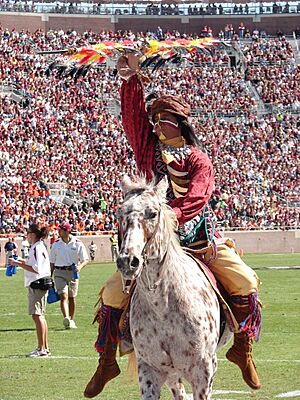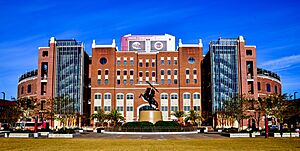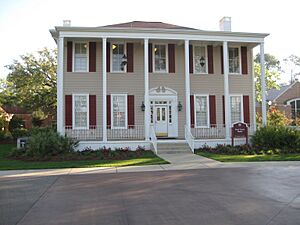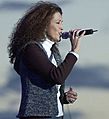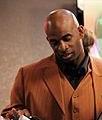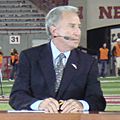Florida State University facts for kids
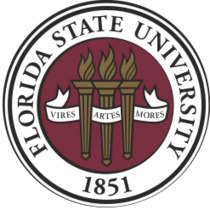 |
|
|
Former names
|
Florida Institute (1854–1857) Tallahassee Female Academy (1843–1858) West Florida Seminary (1857–1860; 1865–1901) The Florida Military and Collegiate Institute (1860–1865) The Literary College of the University of Florida (1883–1885) University of Florida (1885-1902) Florida State College (1901–1905) Florida Female College (1905) Florida State College for Women (1905–1947) |
|---|---|
| Motto | Vires, Artes, Mores (Latin) |
|
Motto in English
|
"Strength, Skill, Character" |
| Type | Public research university |
| Established | January 24, 1851 |
|
Parent institution
|
State University System of Florida |
| Accreditation | SACS |
|
Academic affiliations
|
|
| Endowment | $897.6 million (2021) |
| Budget | $2.17 billion (2021) |
| President | Richard D. McCullough |
| Provost | James J. Clark |
|
Academic staff
|
5,966 |
|
Administrative staff
|
8,133 |
| Students | 45,493 (fall 2021) |
| Undergraduates | 33,486 (fall 2021) |
| Postgraduates | 12,007 (fall 2021) |
| Location |
,
Florida
,
United States
30°26′31″N 84°17′53″W / 30.442°N 84.298°W |
| Campus | Midsize city, 487.5 acres (1.973 km2) (Main Campus) Total, 1,715.5 acres (6.942 km2) |
| Other campuses |
|
| Newspaper |
|
| Colors | Garnet and Gold |
| Nickname |
|
|
Sporting affiliations
|
NCAA Division I FBS – ACC |
| Mascot |
|
 |
|
Florida State University (FSU or Florida State) is a large public university in Tallahassee, Florida, United States. It is a key part of the State University System of Florida. Founded in 1851, it stands on Florida's oldest site for higher education.
FSU has 17 different colleges and over 110 centers. It offers more than 360 study programs. In 2021, 45,493 students from all 50 states and 130 countries attended FSU. Florida State is home to the state's only national lab, the National High Magnetic Field Laboratory. It is also where the anti-cancer drug Taxol was first developed. The university also runs the John & Mable Ringling Museum of Art, which is Florida's State Art Museum.
Florida State University is a top research university. It is known for "Very high research activity." In 2020, the university spent $350.4 million on research and development. This ranked it 75th in the nation. The university has a budget of over $2.17 billion each year. It helps the economy by $14 billion annually.
FSU's sports teams are called the "Florida State Seminoles". They compete in National Collegiate Athletic Association (NCAA) Division I. They are part of the Atlantic Coast Conference (ACC). Florida State's teams have won 20 national championships. Seminole athletes have also won 78 individual NCAA national championships.
Contents
History of Florida State University
Florida State University's beginnings go back to 1823. The U.S. Congress planned to create a system for higher education. In 1845, Florida became a state. This allowed the plans for schools to move forward.
In 1851, Florida's government decided to create two learning institutions. One was to be west of the Suwannee River. These schools would teach people to be teachers. They would also teach skills like mechanics and farming. By 1854, a school for boys called the Florida Institute was in Tallahassee. The state took it over in 1857. This became the State Seminary West of the Suwannee River. In 1858, it joined with the Tallahassee Female Academy. This made it a school for both boys and girls.
The West Florida Seminary was built on a hill. This is where the historic Westcott Building now stands. This area was once known as Gallows Hill.
FSU During the Civil War
In 1860, the school started formal military training. During the American Civil War, it was called The Florida Military and Collegiate Institute. About 250 students attended, making it a large school. In 1865, students from the school helped defeat Union forces at the Battle of Natural Bridge. This kept Tallahassee as the only Confederate capital east of the Mississippi River not captured. After the war, the school went back to its original purpose.
Today, the Florida State University Army ROTC honors these cadets. They display a special banner with "NATURAL BRIDGE 1865" on it. This is a rare honor for a college military unit.
Becoming a State University
In 1883, the West Florida Seminary became The Literary College of the University of Florida. This new university also included a medical college. However, without more money from the state, the university plan struggled. The medical college moved away.
The West Florida Seminary kept growing. It started focusing on college-level education. In 1884, it gave out its first diplomas. By 1897, it became Florida's first liberal arts college. In 1901, it was renamed Florida State College. It offered four-year degrees and even master's degrees. The first master's degree was given in 1902.
The Buckman Act
In 1905, a law called the Buckman Act changed Florida's college system. It created a school for white men (University of Florida), a school for white women (Florida Female College), and a school for African Americans (Florida A&M University). The Florida Female College later became Florida State College for Women. This law was debated because it changed a coeducational school into a women's school.
By 1933, Florida State College for Women was the third largest women's college in the U.S. It was also the first state women's college in the South to get a chapter of Phi Beta Kappa, a respected honor society.
Becoming Florida State University
After World War II, many soldiers used the G.I. Bill to go to college. This put a lot of pressure on the state university system. A branch of the University of Florida opened at the Florida State College for Women. Men lived in temporary housing nearby. In 1947, the Florida Legislature made the FSCW coeducational again. It was then officially named Florida State University. The years after the war brought much growth. Many new departments and colleges were added.
Student Activism and Fairness
During the 1960s and 1970s, FSU became a place for student protests. Students spoke out for racial integration and women's rights. They also protested the Vietnam War. In 1969, students protested against censorship in school newspapers. This led to the president resigning. In 1972, a professor led a lawsuit. It claimed unfair treatment against women in pay. The university later agreed to study and fix these issues.
FSU was sometimes called "Berkeley of the South." This was because of similar student activities at the University of California, Berkeley.
In 1962, Maxwell Courtney became the first African-American undergraduate student at Florida State. In 1968, Calvin Patterson became the first African-American player on the university football team. Today, Florida State has the highest graduation rate for African-American students among all Florida universities.
In 1969, a student group wanted to use university facilities. The university administration did not allow it. This led to a protest and the arrest of 58 students. This event was later called the "Night of the Bayonets." The university's faculty later said the administration's actions made the situation worse. Another big event happened when students protested deaths at Kent State University. Classes were canceled. About 1000 students marched. Governor Claude Kirk even joined them to discuss politics.
The Pride Student Union (PSU) was started in 1969. It supports LGBTQ students. In 2010, the University Board of Trustees passed a rule. It protects students based on their sexual orientation and gender identity.
FSU in the 21st Century
In 2002, FSU students held a protest called "Tent City." They camped for 114 days. They wanted the university to join the Worker's Rights Consortium (WRC). This group checks labor rights worldwide. The protest ended when the university agreed to meet with the WRC.
The Florida State University College of Medicine was created in 2000. It trains future doctors. The King Life Sciences Building opened in 2008. It brought all biology departments together.
In 2013, Florida's Governor Rick Scott named FSU and the University of Florida as "preeminent universities." This means they are top schools in the state. This status brought more state funding to FSU.
FSU Campus
Tallahassee Campus
The main campus covers about 489 acres. It has over 14.8 million square feet of buildings. Florida State University owns more than 1,600 acres in total. The Westcott Building is a very famous structure. It stands on the oldest site of higher education in Florida. It is also home to Ruby Diamond Auditorium, a main performance hall. Dodd Hall, the first library, is also a historic building.
Student dorms like Broward and Landis are on the eastern side of campus. There are also newer dorms like Ragans. Heritage Grove is FSU's Greek community area. It is a short walk away.
FSU has nine libraries on and around campus. The Robert Manning Strozier Library is the main one. It is the only library in Florida open 24 hours Sunday through Thursday. The Dirac Science Library is for science students. The Claude Pepper Library holds documents from famous politicians.
The College of Law is near the Donald L. Tucker Center. The College of Business is in the center of campus. Science and research buildings are in the northwest part. The College of Medicine is on the west side.
Doak Campbell Stadium is in the southwest area. It holds about 84,000 fans for football games. This stadium is unique because it is part of the University Center. This is the largest continuous brick structure in the world. It also holds university offices and classrooms.
The FSU Southwest Campus has another 850 acres. It is home to the Florida A&M University – Florida State University College of Engineering. This is a joint facility with Florida A&M University. The Don Veller Seminole Golf Course is also here. The Florida State University Reservation is a lakeside retreat for students.
Florida State University has been growing a lot since 2003. Many buildings have been renovated or built new. These include sports fields, dorms, and research spaces. The campus is also being made more beautiful.
Panama City Campus
Florida State University Panama City is about 100 miles from the main campus. It started in the early 1980s. Now, it has almost 1,500 students. It offers 15 bachelor's and 19 graduate degree programs.
Over 4,000 students have graduated from FSU Panama City. All courses are taught by professors from the main FSU campus. This campus has a ratio of 25 students to each professor.
How FSU is Organized
| College/school founding | |
|---|---|
| College/school | Year founded |
|
|
|
| College of Arts & Sciences | 1901 |
| College of Human Sciences | 1901 |
| College of Education | 1901 |
| College of Music | 1901 |
| College of Social Work | 1928 |
| School of Dance | 1930 |
| College of Fine Arts | 1943 |
| College of Communication and Information | 1947 |
| School of Information | 1947 |
| Askew School of Public Administration and Policy | 1947 |
| Dedman School of Hospitality | 1947 |
| College of Business | 1950 |
| College of Nursing | 1950 |
| College of Law | 1966 |
| College of Social Sciences and Public Policy | 1973 |
| School of Theatre | 1973 |
| College of Criminology and Criminal Justice | 1974 |
| College of Engineering | 1983 |
| College of Motion Picture Arts | 1989 |
| College of Medicine | 2000 |
| School of Communication | 2009 |
| School of Communication Science and Disorders | 2009 |
| Jim Moran School of Entrepreneurship | 2017 |
| School of Physician Assistant Practice | 2017 |
Florida State University is part of the State University System of Florida. It is overseen by the Florida Board of Governors. A 13-member Board of Trustees helps guide the university.
Jim Clark became the provost of FSU in 2022. He is in charge of the university's daily operations.
FSU has 16 colleges and over 110 centers. They offer more than 300 degree programs. The Florida State University College of Medicine trains doctors. It focuses on helping people in areas with fewer medical services. Students learn on campus for two years. Then they train in hospitals in different cities.
FSU Finances
Fitch Ratings gave FSU a strong financial rating of "AA+" in 2022. This means the university is very stable financially. It shows FSU has good fundraising and manages its money well.
In 2021, FSU's total financial endowment was $897.8 million. The Florida State University Foundation also helps. Its endowment was $669 million in 2021. This money helps pay for student scholarships. It also supports teaching and research.
Seminole Boosters
Seminole Boosters, Inc. supports Florida State University athletics. They raise over $14 million each year. They also get at least $15 million in gifts for buildings. The Boosters help with scholarships and building sports facilities.
Student Government
The Florida State University Student Government Association (SGA) represents the university's students. It has a yearly budget of over $14 million. This money comes from student fees.
The student government started in 1935. It has three parts: executive, judicial, and legislative. The student body president leads the executive branch. The legislative branch has eighty senators. The judicial branch has a chief justice and four other justices.
Academics at FSU
Florida State University wants to be a top 25 public research university. It aims for many of its PhD programs to be in the top 15 nationally. The university is home to the National High Magnetic Field Laboratory. It also has other advanced research facilities. FSU was home to one of the fastest supercomputers in 1989. It also helped develop the anti-cancer drug Taxol.
FSU has 16 colleges and schools. These include colleges for Arts & Sciences, Business, Education, Engineering, Law, and Medicine. Florida State offers many degree programs.
- 104 bachelor's degree programs.
- 112 master's degree programs.
- 70 doctorate degree programs.
- 3 professional degree programs.
The most popular colleges for students are Arts and Sciences, Business, and Social Sciences.
Tuition Costs
For the 2018–2019 school year, tuition was:
- Undergraduate: $215.55 per credit hour for Florida residents. $721.10 per credit hour for out-of-state students.
- Graduate: $479.32 per credit hour for Florida residents. $1,110.72 per credit hour for out-of-state students.
- Law School: $688.11 per credit hour for Florida residents. $1,355.18 per credit hour for out-of-state students.
- Medical School: $479.32 per credit hour for Florida residents. $1,110.72 per credit hour for out-of-state students.
Admissions to FSU
| 2022 | 2021 | 2020 | 2019 | |||
|---|---|---|---|---|---|---|
| Applicants | 78,088 | 65,256 | 63,691 | 58,936 | ||
| Admits | 19,552 | 24,184 | 20,668 | 21,202 | ||
| Enrolls | 6,033 | 7,619 | 6,009 | 7,106 | ||
| Admit rate | 25.0% | 37.1% | 32.5% | 36.0% | ||
| Yield rate | 30.9% | 31.5% | 29.1% | 33.5% | ||
| SAT composite* | 1220–1360 (68%†) |
1200–1330 (65%†) |
1230–1350 (65%†) |
1220–1330 (70%†) |
||
| ACT composite* | 26–31 (32%†) |
26–30 (35%†) |
27–31 (35%†) |
26–30 (30%†) |
||
| * middle 50% range † percentage of first-time freshmen who chose to submit |
||||||
For students starting in Fall 2021, the middle 50% of freshmen had a GPA between 4.1 and 4.5. Their SAT scores ranged from 1230 to 1360. Their ACT scores were between 27 and 31. In 2020, FSU accepted about 32.4% of freshman applicants.
FSU's retention rate for first-year students is 95.1%. This means most students return for their second year. In 2019, 72% of students graduated in four years. This was the highest rate in Florida's state university system.
Student Enrollment
| Academic Year | Undergraduates | Graduate | Total Enrollment |
|---|---|---|---|
| 2017–2018 | 33,008 | 8,354 | 41,362 |
| 2018–2019 | 32,472 | 8,533 | 41,005 |
| 2019–2020 | 33,270 | 9,180 | 42,250 |
| 2020–2021 | 32,543 | 11,026 | 43,569 |
| 2021–2022 | 33,593 | 11,537 | 45,130 |
| 2022–2023 | 32,936 | 11,225 | 44,161 |
In Fall 2021, Florida State University had 45,493 students. They came from over 130 countries and all 50 U.S. states. About 57% of students are women and 43% are men. About 22.6% are graduate students.
| Race and ethnicity | Total | ||
|---|---|---|---|
| White | 59% |
|
|
| Hispanic | 22% |
|
|
| Black | 9% |
|
|
| Other | 5% |
|
|
| Asian | 3% |
|
|
| Foreign national | 1% |
|
|
| Economic diversity | |||
| Low-income | 26% |
|
|
| Affluent | 74% |
|
|
In 2017, 7.1% of FSU students were international students. Most came from China, Panama, and India.
Many in-state students come from Miami-Dade, Broward, Palm Beach, Hillsborough, and Leon counties. The Miami area sends the most students to FSU. For out-of-state students, many come from Georgia, Virginia, and New York.
University Rankings
| ARWU World | 201–300 |
|---|---|
| ARWU National | 66–94 |
| THES World | 251–300 |
| USNWR National University | 55 |
| Washington Monthly National University | 73 |
| Forbes | 67 |
|
USNWR graduate school rankings |
|
|---|---|
| Business | 85 |
| Education | 21 |
| Engineering | 92 |
| Law | 47 |
| Medicine: Primary Care | 78 |
| Medicine: Research | 93–123 |
| Nursing: Doctorate | 33 |
|
USNWR departmental rankings |
|
|---|---|
| Biological Sciences | 80 |
| Chemistry | 49 |
| Clinical Psychology | 27 |
| Computer Science | 82 |
| Criminology | 5 |
| Earth Sciences | 62 |
| Economics | 65 |
| English | 62 |
| Fine Arts | 42 |
| History | 81 |
| Library and Information Studies | 11 |
| Mathematics | 70 |
| Physics | 53 |
| Political Science | 41 |
| Psychology | 62 |
| Public Affairs | 46 |
| Public Health | 79 |
| Social Work | 42 |
| Sociology | 49 |
| Speech-Language Pathology | 20 |
| Statistics | 30 |
In 2022, U.S. News & World Report ranked Florida State University as the 19th best public university in the U.S. It was ranked 55th overall among all national universities.
The FSU College of Business was ranked 27th among public universities in 2019.
Florida State is ranked 16th for the most African American doctorate degrees awarded. The FSU College of Medicine is also ranked among the top 10 for Hispanic and Latino American students.
In 2012, Princeton Review and USA Today called Florida State the fourth "Best Value" public university. FSU is one of Florida's two "preeminent" universities. It also receives the highest research funding from the National Science Foundation in the state.
Honors Program
Admission to the University Honors Program is by invitation. Students usually have high GPAs and test scores. The Honors in the Major Program is for students with at least 60 college hours and a good GPA.
The Presidential Scholars Program is a top scholarship at FSU.
International Programs
Florida State University's International Programs (FSU IP) is ranked 11th in the nation. Each year, over 2,379 students study abroad. Students can take classes for their major or minor. They learn from experts in different fields.
FSU has permanent study centers in London, Florence (Italy), Valencia (Spain), and Panama City (Panama). These centers offer places to live and study.
Career Support
The Florida State University Career Center helps students find jobs. It offers job interviews, career planning, and help with applying to graduate schools. It also helps with internships and fellowships.
Academic Support for First-Generation Students
The FSU Center for Academic Retention and Enhancement (CARE) helps first-generation college students. These are students whose parents did not go to college. CARE provides tutoring, advising, and life coaching. It started in 2000. By 2017, over 5,500 students had used its services.
CARE students have a high first-year retention rate of 97%. Their six-year graduation rate is 81%. The Summer Bridge Program (SBP) is an admission program for these students. The Unconquered Scholars Program helps students who have been in foster care or experienced homelessness.
FSU Libraries
The Florida State University Libraries have one of the largest collections in Florida. They have over 3.75 million books. Their website offers access to over 400 databases and 200,000 e-journals. FSU has 15 libraries in total. Eight are on the main campus in Tallahassee. The others are around the world.
The Robert M. Strozier Library is FSU's main library. It is in the center of campus. It focuses on Humanities, Social Sciences, and Education. It is open 24 hours on weekdays during fall and spring.
The Paul A. M. Dirac Science Library is for science students. It has over 500,000 books. It also has computers for students to use.
The Claude Pepper Center has a library with documents from Claude Pepper, a famous politician. It also has a collection from former Florida Governor Rubin Askew. This center helps older Americans.
The Warren D. Allen Music Library is in the Housewright Music Building. It has over 150,000 music scores, recordings, and books.
The Florida State University College of Law Research Center is the law school's library. It has over 500,000 volumes of law books.
FSU also has libraries at its Panama City campus, in Panama, and at its study centers in Florence, Italy, and London. The John and Mable Ringling Museum of Art also has a library.
Museums at FSU
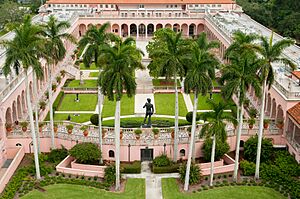
The Ringling is Florida's State Art Museum. It is in Sarasota, Florida. Florida State University manages it. The museum started in 1927. It has 21 galleries of European paintings. It also has art from Cyprus, Asia, and America. The museum has over 10,000 art objects. Its most famous pieces are paintings by Peter Paul Rubens. The Ringling Museum is the largest university museum complex in the U.S.
The Ringling campus has grown. It includes the art museum, a circus museum, and the Ringlings' mansion, Cà d'Zan. New buildings have been added for visitors and learning.
Florida State University also has the FSU Museum of Fine Arts (MoFA) on its Tallahassee campus. MoFA has over 4,000 art items. These include ancient pottery and modern art. It has many prints by famous artists like Rembrandt and Pablo Picasso.
Research at FSU
Florida State University is one of Florida's main research universities. It does a lot of scientific research. FSU conducts research at all levels, from undergraduate to postdoctoral.
In 2020, Florida State University received $350.4 million for research. This ranked it 75th in the nation. FSU is also one of the top 15 universities to get funding for physical sciences from the National Science Foundation.
FSU has 19 graduate degree programs that combine different research fields. This means experts from different areas work together. This helps them make new discoveries.
National High Magnetic Field Laboratory
The National High Magnetic Field Laboratory (NHMFL), or "Mag Lab," is at Florida State. It creates strong magnetic fields for scientists to use. They do research in physics, biology, chemistry, and engineering. It is the only lab of its kind in the U.S. It is one of only nine in the world. The Mag Lab has set 14 world records. It is the largest and most powerful lab of its kind.
Large Hadron Collider Research
FSU faculty helped design and build the Compact Muon Solenoid (CMS). This is a detector for the Large Hadron Collider (LHC). The LHC is a huge particle accelerator near Geneva, Switzerland. Some parts of the LHC were put together at Florida State. Then they were shipped to Switzerland. FSU faculty helped with key parts of the CMS detector.
High-Performance Materials Institute
The High-Performance Materials Institute (HPMI) is a research center. It focuses on new materials. These include strong composite materials and tiny nanomaterials. They also work on ways to check the health of structures.
Center for Advanced Power Systems
Florida State University's Center for Advanced Power Systems (CAPS) is a special test site. The U.S. Navy trusts it to test new power technology for ships.
CAPS researches power systems technology. It works with public utilities, defense, and transportation. CAPS helps train future power system engineers. Their research includes power system models, power electronics, and superconductors. In 2015, CAPS built a 24,000-volt direct current power test system. This is the most powerful system at a university research center worldwide.
Coastal and Marine Laboratory
The FSU Coastal and Marine Laboratory (FSUCML) is about 45 miles from the main campus. It is on the coast of St. Teresa, Florida. The FSUCML studies the ocean and coastal areas of the Gulf of Mexico. It helps solve environmental problems. It also helps make public policy decisions.
FSU has done marine research since 1949. The lab moved to its current location in the 1960s. In 2006, it was renamed to reflect its broader research and education goals.
Student Life at FSU
Traditions
The university's colors are garnet and gold. These colors represent FSU's history. In the early 1900s, the football team wore purple and gold. Later, the students chose crimson. In 1905, crimson was combined with purple to make garnet. After World War II, garnet and gold became the official colors. Florida State University's marching band is the Marching Chiefs.
Alma Mater
The alma mater for Florida State University is "High O'er Towering Pines." Charlie Carter wrote it in 1956.
Other popular FSU songs include:
- Hymn – "Hymn To the Garnet and Gold"
- Fight Song – "FSU Fight Song"
Residential Life
Florida State University offers housing for 6,733 students. This number will soon increase to 7,283. Most students live on campus in dorms. Some live in private housing nearby. FSU also has Living–Learning Communities (LLC). These are dorms where students with similar interests live together.
Student Clubs and Activities
Florida State University has over 750 student organizations. These include groups for culture, sports, and charity. Some popular groups are Phi Beta Kappa, AcaBelles, and the Marching Chiefs. Students can also create their own groups. All groups get funding from the student government.
Fitness and Sports
The Bobby E. Leach Student Recreation Center is a large fitness facility. It has basketball courts, racquetball courts, and an indoor track. The Leach Pool is an indoor swimming facility.
Florida State University also has an intramural sports program. Students can play sports like flag football, basketball, and recreational soccer. Sports clubs like equestrian and water sailing compete against other colleges.
A new area for intramural sports, the RecSports Plex, opened in 2007. It is the largest in the nation. It has many fields for football, soccer, and softball.
Entertainment
Much of student life happens at the FSU Student Union. It was built in 1952 and expanded in 1964. It was rebuilt and reopened in 2022. Crenshaw Lanes is a bowling alley inside the Union. It also has billiard tables.
Club Downunder hosts bands and comedians. These shows are free for FSU students. Past performers include The White Stripes and Modest Mouse.
The Askew Student Life Center has the Student Life Cinema. This is a movie theater run by students. Movies are free for students. The center also has a ceramic painting program and a video game area.
Florida State's Reservation is a 73-acre lakeside area. It is a place for students to relax. It was founded in 1920.
FSU is one of only two colleges in the country with a circus. The FSU Flying High Circus started in 1947. It is an extracurricular activity.
A Cappella Groups
FSU has five student-run a cappella groups. These include Acaphiliacs, All-Night Yahtzee, and AcaBelles. All groups compete in the International Championship of Collegiate A Cappella (ICCA). All-Night Yahtzee has competed in the finals five times.
Greek Life
About 14% of undergraduate men are in a fraternity. About 23% of undergraduate women are in a sorority. FSU has many Greek organizations. These include fraternities and sororities.
In 2017, the university president stopped all Greek activities for a time. This was to create new policies. The goal was to improve student culture.
Reserve Officer Training Corps
Florida State University's Reserve Officer Training Corps (ROTC) trains students to become military officers. The FSU ROTC unit is one of only four college military units allowed to display a battle streamer. This is for the students' service in the Battle of Natural Bridge in 1865.
ROTC offers training for the United States Army and the United States Air Force. FSU students can also train with Florida A&M University's Navy ROTC. This allows them to join the Navy or Marine Corps.
Campus Transportation
The Seminole Express Bus Service has eight bus routes. It provides transportation around campus and to nearby Tallahassee areas. Students, faculty, and staff can ride any StarMetro bus for free with their FSUCard. FSU also offers other services like the Spirit Shuttle for football games.
The Tallahassee International Airport serves Florida State University. It has daily flights to major cities like Miami and Atlanta.
Student Media
The campus newspaper is the FSView & Florida Flambeau. It publishes weekly or semiweekly. FSU also runs two TV stations, WFSU and WFSG. It operates three radio stations, WFSU-FM, WFSQ-FM and WFSW-FM.
FSU also has a student-run radio station, WVFS (V89). It plays independent music. The English Department publishes a literary journal called The Southeast Review.
FSU Athletics
The school's athletic teams are called the Seminoles. This name comes from the Seminole people. The students chose the name in 1947. The Seminole Tribe of Florida officially approves its use.
FSU athletes compete in the NCAA's Division I. They are part of the Atlantic Coast Conference.
For the 2017–2018 school year, the Florida State Athletics Department had a budget of $103.2 million. It brought in over $121.3 million in revenue. Florida State University is known for its strong sports teams.
Men's sports include baseball, basketball, and football. Women's sports include basketball, soccer, and softball. FSU also has club sports like rugby and lacrosse.
FSU has three main sports venues on campus:
- Doak Campbell Stadium for football.
- Dick Howser Stadium for men's baseball.
- Donald L. Tucker Center for men's and women's basketball.
The Mike Long Track is home to the men's track and field team. The Seminole Soccer Complex is home to women's soccer. The Seminole Softball Complex is home to the women's softball team.
Seminole Baseball
Seminole baseball is one of the most successful college baseball programs. They have been to the College World Series 20 times. They reached the national championship final three times. Under Coach Mike Martin, Florida State is the second-winningest program in college baseball history. Since 1990, FSU has had more 50-win seasons than almost any other team.
Seminole Football
The Florida State Seminoles football program has played in 49 bowl games. They have won three national championships. They also won eighteen Atlantic Coast Conference (ACC) championships. FSU football has produced 218 All-Americans. It has also had 47 players chosen in the first round of the National Football League (NFL) draft. Three FSU players have won the Heisman Trophy. The Seminoles had 14 straight years ranked in the top five of the AP Poll.
The Seminoles' home field is Bobby Bowden Field at Doak Campbell Stadium. It can hold 79,560 fans.
Florida State's first official football team played in 1902. They were called "The Eleven." In 1904, they became the first state champions of Florida.
Under head coach Bobby Bowden, the Seminole football team became one of the best. They played in five national championship games between 1993 and 2001. They won championships in 1993 and 1999. Coach Bowden retired with the most career wins in Division I football. Jimbo Fisher took over in 2010 and won a national championship in 2013. The current head coach is Mike Norvell. Many FSU football players have gone on to play in the NFL. These include Deion Sanders and Jameis Winston.
Seminole Track and Field
The FSU men's Track & Field team won the Atlantic Coast Conference championship four times in a row. They also won the NCAA National Championship three years in a row. In 2006, Coach Bob Braman led individual champions in various events. In 2007, FSU won its second straight men's Track & Field NCAA National Championship.
FSU Faculty
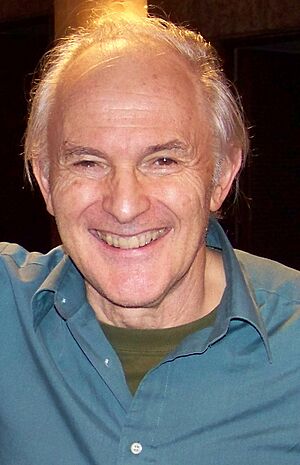
Florida State University has 2,548 faculty members and over 8,133 staff. FSU students get to learn from amazing professors. These include a Nobel Laureate and members of the National Academy of Sciences. Many faculty members have won major awards in arts and sciences.
Robert A. Holton, a chemistry professor, developed the first way to create the anti-cancer drug paclitaxel. This drug was previously only found in a rare tree. FSU made a deal with a company to use this invention.
FSU's Department of Art has many famous artists. Mark Messersmith, Lillian Garcia-Roig, and Ray Burggraf are known for their art. Their work often focuses on the environment.
FSU Alumni
Florida State University has over 400,000 former students. They live in all 50 states and many countries. Many FSU alumni are college presidents. Over 15 have served in the United States Congress. Four have been governors. More than 20 have become generals or admirals in the United States Armed Forces.
Florida State University has had five Rhodes Scholarship recipients. This is a very high honor. Garrett Johnson, Joe O'Shea, and Myron Rolle are FSU alumni who won this award. Only 32 students in the U.S. get this award each year.
Many FSU graduates have become important people.
- Politicians: Mel Martinez, Kay Hagan, Matt Gaetz, and Governors Charlie Crist and Reubin Askew.
- Judges and Lawyers: Judges Susan H. Black and Ricky Polston, and civil rights attorney Benjamin Crump.
- Military: Generals Frank Hagenbeck and Kenneth Minihan.
- Arts and Entertainment: Video game designer Neil Druckmann, musicians Rita Coolidge and Jim Morrison, directors Barry Jenkins and Colleen Clinkenbeard, actors Burt Reynolds and Cheryl Hines.
- Other Notables: Astronauts Norman Thagard and Winston Scott, scientist Sylvia Earle, and fitness guru Richard Simmons.
As a top sports school, FSU has many famous alumni in sports. Many are in FSU's Hall of Fame. Over 123 alumni play professional sports. FSU has produced three Heisman Trophy winners: Chris Weinke, Charlie Ward, and Jameis Winston. Famous professional golfers include Brooks Koepka and Hubert Green.
Images for kids
-
Sara Blakely, founder of Spanx
See also
 In Spanish: Universidad Estatal de Florida para niños
In Spanish: Universidad Estatal de Florida para niños
- Burning Spear Society
- Florida State University School
- Florida State University Police Department
- List of colleges and universities in Florida
- Marching Chiefs
- Master Craftsman Studio
- National Center for Choreography
- The War Chant


